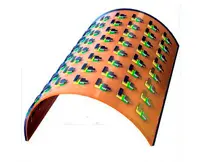 Researchers at Korean science and technology institute KAIST say they have developed a flexible phase change RAM (PRAM) featuring self assembled block copolymer silica nanostructures on a plastic substrate. The team also claims the device consumes 75% less power than a conventional PRAM.
Researchers at Korean science and technology institute KAIST say they have developed a flexible phase change RAM (PRAM) featuring self assembled block copolymer silica nanostructures on a plastic substrate. The team also claims the device consumes 75% less power than a conventional PRAM.
PRAM is a candidate for use in flexible and wearable electronics, but the operating current needs to be reduced. While one solution is to decrease cell size, scaling on flexible substrates is difficult due to the soft nature of plastics and photographic limitations.
KAIST's Professor Keon Jae Lee said: "The demonstration of low power PRAM on plastics is one of the most important issues for next generation wearable and flexible non volatile memory. Our innovative and simple methodology represents the strong potential for commercialising flexible PRAM."
The block copolymer (BCP) – a mixture of two polymer materials – allows the creation of self ordered arrays of sub 20nm features through spin coating and plasma treatments. BCP silica nanostructures lowered the contact area by localising the volume change of the phase change materials, reducing power consumption significantly. Ultra thin silicon based diodes were also integrated with phase change materials to suppress inter cell interference, demonstrating random access capability for flexible and wearable electronics.
Author
Graham Pitcher
Source: www.newelectronics.co.uk

